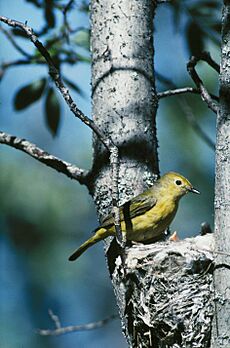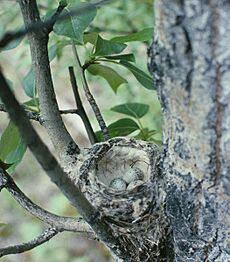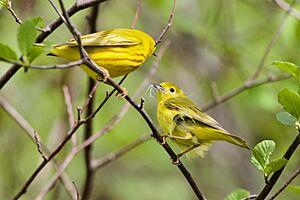Yellow warbler facts for kids
Quick facts for kids Yellow warbler |
|
|---|---|
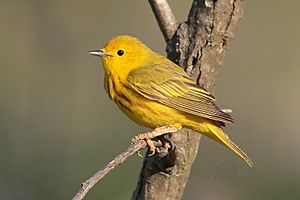 |
|
| Male in breeding plumage, Canada | |
| Conservation status | |
| Scientific classification | |
| Genus: |
Setophaga
|
| Species: |
petechia
|
| Subspecies | |
|
About 35 (but see text) |
|
 |
|
| Distribution of the yellow warbler Breeding range Year-round range Wintering range | |
| Synonyms | |
|
|
The Yellow Warbler (Setophaga petechia) is a small, colorful bird found across a wide area. It's a type of New World warbler, which are songbirds mostly found in the Americas. Yellow Warblers are the most common species in their group, called Setophaga. They build their nests and raise their young in almost all of North America, the Caribbean, and even parts of northern South America.
Contents
What's in a Name?
The name Setophaga comes from ancient Greek words. Ses means "moth," and phagos means "eating." So, it means "moth-eating." The second part of its scientific name, petechia, comes from an Italian word. It refers to small red spots on the skin. This describes the rusty-red streaks often seen on the bird's chest.
Meet the Yellow Warbler: Description and Types
Yellow Warblers are quite similar, except for the males' colors during breeding season. Also, their body sizes can vary. In winter, and for females and young birds, their upper bodies are greenish-yellow. Their undersides are a duller yellow. Young males quickly get their bright chest and head colors. Females are usually a bit duller, especially on their heads.
All Yellow Warblers have dark, blackish-olive flight feathers. These feathers have yellow edges. Sometimes, these edges look like a faint yellow band on their wings. Their eyes and short, thin beak are dark. Their feet are a lighter or darker olive-buff color.
There are about 35 different types, or subspecies, of Yellow Warblers. These can be grouped into three main types based on the male's head color. Sometimes, each of these groups is seen as a separate species. However, the aestiva group (the American Yellow Warbler) is currently considered a separate species from the petechia group (which includes the Mangrove and Golden Warblers).
How Big Are They?
Yellow Warblers can be anywhere from 10 to 18 centimeters (4 to 7 inches) long. Their wingspan can range from 16 to 22 centimeters (6 to 9 inches). They weigh between 7 and 25 grams (0.25 to 0.9 ounces). This weight changes depending on the subspecies and whether they are migrating. On average, they weigh about 16 grams (0.56 ounces). However, most breeding adults in the United States weigh only 9 to 10 grams (0.32 to 0.35 ounces).
The males in summer are usually the brightest yellow warblers you'll see. They are bright yellow below and greenish-golden above. They often have a few wide, reddish streaks on their chest and sides. These markings are why they are called petechia, meaning "spotted." Different types of Yellow Warblers vary in brightness and size. This often follows rules like Bergmann's Rule (larger in colder climates) and Gloger's Rule (darker in humid climates).
Golden Warbler Group
The Golden Warbler (petechia group) includes 17 subspecies. These birds usually live in mangrove swamps in the West Indies. They might move locally during different seasons. For example, on the Cayman Islands, one type of Golden Warbler was very common for breeding. But in some winters, they were hard to find. This suggests they might spread out to other areas when not breeding.
Golden Warblers are generally small. They usually weigh 10 grams (0.35 ounces) or less. Some can weigh as little as 6.5 grams (0.23 ounces). Summer males in this group have a reddish-brown crown, hood, or mask on their heads. The different types in this group vary in how much of their head is covered and the exact shade of red.
Mangrove Warbler Group
The Mangrove Warbler (erithachorides group) has 12 subspecies. These birds tend to be larger than other Yellow Warbler groups. They average 12.5 centimeters (5 inches) long and weigh about 11 grams (0.39 ounces). They live in mangrove swamps along the coasts of Central America and northern South America. One type, S. p. aureola, is found on the Galápagos Islands.
Summer males in this group also have a reddish-brown hood or crown. The different types vary in how much of their head is covered and the color of the hood. This can make them look very similar to the Golden Warbler group.
American Yellow Warbler Group
The American Yellow Warbler (aestiva group) has 6 subspecies. These birds breed across temperate North America, reaching as far south as central Mexico. They prefer open, often wet, woods or shrubs. They are migratory, meaning they fly south for winter. They spend winter in Central America and South America. They are very rare visitors to western Europe and Scandinavia.
-
Resident adult male mangrove warbler S. p. bryanti, Quepos, Costa Rica
-
Breeding male golden warbler S. p. petechia, Washington-Slagbaai National Park, Bonaire, (Netherlands Antilles)
-
Breeding male mangrove warbler S. p. aureola, Puerto Ayora, Santa Cruz (Galápagos Islands)
-
Breeding female S. p. aestiva, Horicon Marsh, Wisconsin (United States)
-
Male resident Cuban yellow warbler S. p. gundlachi, Cuba
Sounds and Songs
The Yellow Warbler's song is a lovely, musical tune. People often describe it as "sweet sweet sweet, I'm so sweet." However, the song can sound quite different depending on where the birds live. Their call is a soft or louder "chip" or "ship." Females often make this sound after a male finishes his song.
When defending their territory, they make hissing sounds. They also have a special "seet" call. This call seems to be a warning about cowbirds, which are birds that lay their eggs in other birds' nests. Yellow Warblers also use other calls to talk to their mates or neighbors. Young birds use calls to beg for food. These birds also communicate using different body positions and possibly by touching each other.
Yellow Warbler Life and Habitat
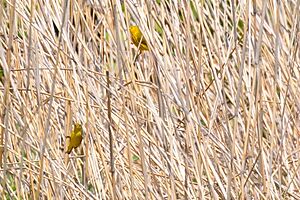
American Yellow Warblers breed across most of North America. They live from the cold tundra regions southwards. However, they are not found in the far Southwest or along the Gulf of Mexico coast. During winter, American Yellow Warblers fly south. They can be found from southern California all the way to the Amazon region, Bolivia, and Peru. The Mangrove and Golden Warblers live even further south, reaching the northern parts of the Andes mountains.
American Yellow Warblers usually arrive in their breeding areas in late spring, around April or May. They start moving back to their winter homes as early as July, once their young birds can fly. Most, however, stay a bit longer. By the end of August, most northern populations have moved south. Some might stay almost until fall.
The American Yellow Warbler prefers to breed in areas near water. These are often wet lands with many small trees, especially willows. The other groups, and all Yellow Warblers in winter, mainly live in mangrove swamps and similar thick, woody areas. They less often live in shrubland, farmland, or the edges of forests. American Yellow Warblers will also come to suburban areas, orchards, and parks. They might even breed there. Outside the breeding season, these warblers are usually seen in small groups. But during breeding, they strongly defend their territory. They will try to chase away any other Yellow Warbler that comes too close.
What Do Yellow Warblers Eat?
About 60% of a Yellow Warbler's diet is caterpillars. They also eat wasps, mayflies, moths, mosquitoes, beetles, damselflies, and other insects. They also enjoy insect larvae and spiders. They find their food by picking insects off shrubs and tree branches. They also catch flying prey in the air. They eat other invertebrates and some small, juicy fruits, especially American Yellow Warblers in their winter homes.
Yellow Warblers are one of several birds that help farmers. They reduce the number of coffee berry borer beetles in coffee farms in Costa Rica by 50%. Caterpillars are the main food for baby birds. Some types of caterpillars, like those from geometer moths, are preferred over others.
Who Hunts the Yellow Warbler?
Yellow Warblers are small birds that build nests in trees. Their predators are typical for such birds. These include snakes, foxes, birds of prey, and many others. An adult American Yellow Warbler has about a 50% chance of surviving from one year to the next. In southern populations, about two-thirds of adults survive each year.
However, less than one in three American Yellow Warbler nests are attacked by predators. For Mangrove and Golden Warbler nests, two out of three are affected. Snakes, like the blue racer and common garter snake, often eat eggs and baby birds. They might also catch sick or distracted adult birds. Birds like the American crow and blue jay, and climbing rodents like the American red squirrel, also attack nests.
Other animals that hunt them include carnivores like the striped skunk, long-tailed weasel, common raccoon, red fox, and domestic or feral cats. These animals usually don't threaten adult birds that are not nesting. Agile birds like the American kestrel, Cooper's hawk, and sharp-shinned hawk hunt adult Yellow Warblers. Other birds of prey, such as peregrine falcons and merlins, also hunt them. Owls, like great horned owls and eastern screech owls, have been known to attack Yellow Warblers of all ages at night.
Yellow Warblers rarely gather to chase away predators. But they do mob cowbirds. Cowbirds are a big problem because they lay their eggs in other birds' nests. About 40% of American Yellow Warbler nests are affected by brown-headed cowbirds. Tropical populations are less often affected by shiny cowbirds, with only 10% of nests. This might be because shiny cowbirds are slightly larger. They are less likely to survive being fed by the much smaller warbler.
The Yellow Warbler is one of the few songbirds that can recognize cowbird eggs in its nest. When it finds one, the warbler often covers it with a new layer of nesting material. It usually doesn't try to save its own eggs that have already been laid. Instead, it will lay a new set of eggs. Sometimes, the parents leave a nest with cowbird eggs and build a new one. Cowbird chicks don't kill the host bird's chicks. So, nests can have both Yellow Warbler and cowbird chicks that successfully fly away. However, cowbird chicks are much larger. This makes it harder for the Yellow Warbler parents to raise their own young successfully.
Other reasons for Yellow Warbler deaths are not well known. The oldest recorded Yellow Warblers in the wild lived about 10 years.
Reproduction and Life Cycle
Like other members of the Parulidae family, Yellow Warblers build their nests in trees. They make a small but very strong cup-shaped nest. Both female and male parents help raise the young. But they focus on different jobs. Females spend more time building and taking care of the nest. They also sit on the eggs to keep them warm and keep the baby birds warm. Males spend more time guarding the nest and finding food. They bring food to the nest and give it to the mother, who does most of the actual feeding. As the young birds get ready to leave the nest, the male does more of the work.
American Yellow Warblers and Mangrove Warblers (including Golden Warblers) have some differences in how they reproduce. American Yellow Warblers start breeding in May or June. Mangrove Warblers, however, breed all year round. American Yellow Warblers can raise a group of young in as little as 45 days, but 75 days is more common. Tropical populations, on the other hand, need more than 100 days for each breeding cycle.
Males try to attract females by singing. They can sing 3,200 or more songs per day. Like most songbirds, they usually have one mate at a time. However, about 10% of Mangrove Warbler males and 5% of American Yellow Warbler males have two mates. Very few American Yellow Warblers breed more than once a year. Only about 5% of female Mangrove Warblers do so. If a breeding attempt fails, either parent will usually try to raise a second group of young.
The American Yellow Warbler usually lays 3 to 6 eggs, most often 4 or 5. It's rare for them to lay only 1 or 2 eggs. The eggs usually hatch after 11 days, but sometimes it can take up to 14 days. The baby birds weigh about 1.3 grams (0.05 ounces) when they hatch. They are kept warm by their parents for about 8 to 9 days after hatching. They leave the nest the next day or the day after. The Mangrove Warbler lays only about 3 eggs per group and sits on them for about 2 days longer. Its baby birds are kept warm for about 11 days after hatching.
Almost half of the parents (more so for Mangrove Warblers than American Yellow Warblers) take care of their young for two weeks or more after they leave the nest. Sometimes, the adult parents separate early. Each parent might go with one to three of the young birds. About 3 to 4 weeks after hatching, the young birds can live on their own. They can start having their own babies when they are one year old. About 55% of all American Yellow Warbler nests successfully raise at least one young bird. In contrast, only 25% of Mangrove Warbler nests successfully raise any young. Accidents and predation often cause all the eggs or young to be lost.
Status and Protecting Yellow Warblers
Yellow Warblers, especially the young ones, eat many pest insects during the breeding season. People describe the male's bright colors and musical song as "lovely." This encourages ecotourism, where people travel to see nature. There are no known major negative effects of American Yellow and Mangrove Warblers on humans.
The Yellow Warbler is common and found over a large area. Because of this, the IUCN does not consider it a threatened species. However, their numbers have decreased in some local areas. This is mainly due to habitat destruction and pollution. The main causes are clearing land, too much use of land for agriculture, and the use of herbicides and pesticides. Sometimes, too much grazing by animals also harms their habitat. But their numbers usually recover quickly if their riverside habitat is allowed to grow back. This is especially true for the American Yellow Warbler, which has many young.
The North American populations of Yellow Warblers are legally protected by the Migratory Bird Treaty Act. The Barbados Golden Warbler (D. p. petechia) has been listed as "endangered foreign wildlife" by the United States' Endangered Species Act (ESA) since 1970. This means it is illegal to bring it into the USA, except for special scientific, educational, or conservation reasons. The Californian Yellow Warbler (D. p./a. brewsteri) and Sonoran Yellow Warbler (D.p./a. sonorana) are listed as "species of concern" by the ESA. This means they are being watched closely because their populations might be at risk.








